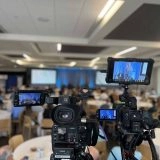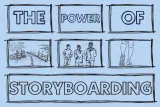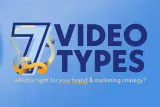6 Tips to Foster Creativity: The Power of Diverse Perspectives
General
 Posted by: DreamOn Studios 1 year ago
Posted by: DreamOn Studios 1 year ago
At DreamOn Studios, we believe effective storytelling starts with harnessing the collective value of unique perspectives and coming together to create something captivating. There are a few things that come into play when working with a group of creatives and our clients.
- Each team member possesses a distinct background, set of experiences, and creative approach, all of which contribute to the richness and depth of our work.
- Each client we partner with has a unique vision or a problem they want to solve, and sometimes a creative approach may not necessarily align with what they imagine.
Yet, something amazing often happens when we bring together differing viewpoints to create something compelling, and everyone wins! To do this takes skills in collaboration, communication, and deep listening.
In this article, we’ll explore the tips and best practices we’ve learned about incorporating different perspectives, managing collaboration, and navigating potential challenges to produce amazing outcomes!

6 Tips to Foster Creativity Through Collaboration
#1 Listen actively
Active listening is a communication technique that involves fully focusing on and understanding others. It goes beyond simply hearing what someone says and consists in being attentive to verbal and non-verbal cues while seeking clarity about what someone is trying to convey.
To practice active listening with our team and with clients to promote creativity, here are some tips we integrate into our meetings with our clients and with each other:
- Be present: Provide eye contact, eliminate distractions, and show genuine interest.
- Stay curious: Ask open-ended and follow-up questions that get people to open up and share their ideas, opinions, and concerns.
- Engage verbally and non-verbally: Use cues to demonstrate that you’re paying attention—nod, smile, and say things like, “Tell me more!”
- Avoid interrupting: Wait for the appropriate pauses to ask questions and seek clarity.
- Seek clarity: If you don’t understand something or need clarification, don’t hesitate to ask, restate, or paraphrase to ensure understanding.
- Suspend judgment: Avoid assuming or jumping to conclusions about what someone is saying. Instead, ask questions to seek understanding.
- Reflect on what you understand: To reemphasize clarity, share what you understand about what you heard.
- Practice patience: Allow people to express themselves, even if it might take longer.
#2 Cast vision
Vision casting is crucial in any project as it helps align the client’s expectations and the creative team’s understanding of the desired outcome.
But before we cast vision, we go to step one and start with deep listening. We know we’ll likely fail at casting vision if we don’t understand our client’s goals and needs first.
Once we understand what our client wants to accomplish, we move through these steps:
- Craft a compelling narrative: Think about the story we want to tell, the emotions we want to evoke, or the impact we want to create. This narrative will set the tone.
- Create a visual presentation: Bring the narrative to life and give people a taste of what we envision. This can include mood boards, concept art, reference images, or storyboards.
- Collaborate and iterate: Welcome feedback from our client to help refine or iterate the concept. Bring back active listening to this part of the process.
- Translate the vision to the creative team: If we haven’t collaborated with our team on the vision by this point, we share the final vision with our team, encourage questions and ideas, and seek affirmation of their understanding of the vision.
- Invite ideas: While the vision has been cast, the project is still a piece of clay waiting to be molded into something great. We welcome our team to share perspectives and ideas on improving the concept to foster ownership.
#3 Seek out diverse perspectives
Seeking diverse perspectives in a creative process is essential for generating innovative ideas, fostering inclusivity, and producing high-quality outcomes.
At DreamOn Studios, we not only want to welcome ideas from each other, but we also want to seek out the best ideas from outside of our team. Ultimately, different perspectives sharpen our view to provide the best possible solutions for our clients.
We do this by immersing ourselves in learning opportunities that expose us to creative ideas that may be outside of our usual way of doing things and experiencing cultures and places that may be different from how we grew up.
Where can we seek out diverse perspectives?
- Networking outside our industry
- Connecting with different generations
- Reading books on topics we might not typically read
- Traveling to other cities, states, or countries
- Visiting new churches
- Eating at restaurants outside our comfort zone
#4 Focus on reactions rather than criticisms
When working with a client and a creative team, we are bound to hear and give feedback and criticism. Feedback and criticism are not something to be feared! Rather, by embracing it with an objective perspective, we know we can create something even better than we could without it.
Ultimately, our team and our clients want to create something compelling and great, so it’s important for the work or project to be the focus. To do that well, we consider people’s reactions to the work rather than their criticism. What do we mean?
For example, if our creative team presents us with their first draft of a video project for a client with the goal of inspiring people to buy a product, but it misses the mark, we might help them think differently about how to improve it by sharing our reactions.
Our reactions might sound something like this:
- I feel confused about what to do next. How might you add clarity here?
- This section gives me goosebumps. How could you expand on that?
- I get lost in the speed of this section. What would you do for someone who takes things in slowly?
- I found myself disengaging near the end. How would you make it concise?
Notice that the feedback doesn’t tell someone what to do as much as it gets them to respond to reactions and prompts. The goal is to provide feedback that encourages growth, offers concrete suggestions, and acknowledges effort.
By focusing on reactions and maintaining a positive and supportive tone, we can help the creator navigate their way towards a better end product.
We can flip this feedback approach around with our clients as well! When receiving feedback from clients on creative projects, we ask questions like this to help understand their needs:
- What stands out?
- How does it make you feel?
- What does it make you want to do?
- What feels confusing?
- What feels right?
- What feels off?
- Where are there missed opportunities?
#5 Manage conflict by solving objective problems
Conflict can arise when working with diverse and creative perspectives, but fortunately, conflict can often produce even greater ideas and products!
It’s important to promote healthy conflict and discussions to take advantage of the creative benefits. To do that, we focus our conversations on solving a common problem with these helpful steps:
- Acknowledge and validate perspectives: Listen to all sides of the argument to understand each person’s unique perspective. Where are they coming from? What are the pain points of each side? What are the benefits of each side?
- Define the common goal: Remind each other of the common goal, and focus on the best solution. Personal preferences aside, what is the best decision for the client, considering their goal and vision?
- Identify shared interests: Find common ground. What does everyone agree on?
- Encourage collaboration: Brainstorm new ideas together for other possible solutions that could potentially incorporate different approaches.
Special Note: Managing conflict can often move into personal territory, where the conflict goes beyond solving problems about a project and moves into areas related to self-esteem or personality differences.
When personal conflict arises, there is more at play than a simple disagreement about creative preferences. It’s important to pause and focus on the relationship to re-establish trust.
Ask questions to identify the issue’s root, including, How do you feel? When did you start feeling this way? What contributed to it? What are your concerns? What do you wish would change?
#6 Clearly articulate expectations and roles
Successful collaboration relies on clear and effective communication. To do that well, we must articulate clear expectations about who is responsible for what and by when so that important details don’t fall through the cracks—this goes for clients and teammates alike.
This tip may feel tedious; however, when it’s lost, we will likely not accomplish much.
- Identify and assign roles: In a team of creatives, everyone must know what is expected of them to accomplish a goal.
- Set realistic, achievable goals: Understand the full scope of the project and how long each aspect will take, planning back the calendar appropriately.
- Keep communication open: Be transparent about roadblocks, misunderstandings, and progress, and adjust as needed as we move through the process.
When utilized well, this level of clarity produces confidence in our team and our clients!
Pro Tip: We utilize programs like Asana for project management, giving our team an overview and an in-depth view of each project and where it is in the process. For creative teams especially, this is a game-changer!
Takeaway: Celebrate Uniqueness & Get Creative!
By implementing these six tips, we harness the power of diverse perspectives to spark creativity, generate innovative ideas, and deliver outstanding results for our clients.
Embracing diversity in the creative process is rewarding and essential for creating work that stands out.
At DreamOn Studios, we celebrate the uniqueness of each team member and client, knowing that it is through our collaboration that true creative magic happens.
We’d love to create with you! Are you ready to collaborate? Schedule your discovery call or studio tour today!
Categories:
About: DreamOn Studios
You May Be Interested In:

10 Ways to Remix, Repurpose, & Reimagine Your Video
3 weeks ago by DreamOn Studios

Case Study: Video for Employee Engagement at Witt Family Home Stores
1 month ago by DreamOn Studios

Storyboarding Benefits, Tips & Tricks for Stand Out Videos
3 months ago by DreamOn Studios

7 Video Types: Which is Right for Your Brand and Marketing Strategy?
4 months ago by DreamOn Studios